
Whether you’re trying to save a few bucks, or you just like the challenge of doing everything yourself, at some point you’ll probably consider painting your own motorcycle. But not everyone has their own air compressor at home, or a spray booth and a decent spray gun.
But who says you can’t paint a motorcycle in your home shop with aerosol paint? Okay, you might not get the same result as a professional painter with a spray booth. It won’t be as durable as modern, two-part automotive paint. And you’ll probably spend time and money stripping it off and sending it to a professional after you change your mind.
But if you want to learn some new skills, get a perfect color match, and get the satisfaction of doing it yourself, stick with me and speed up your learning curve.
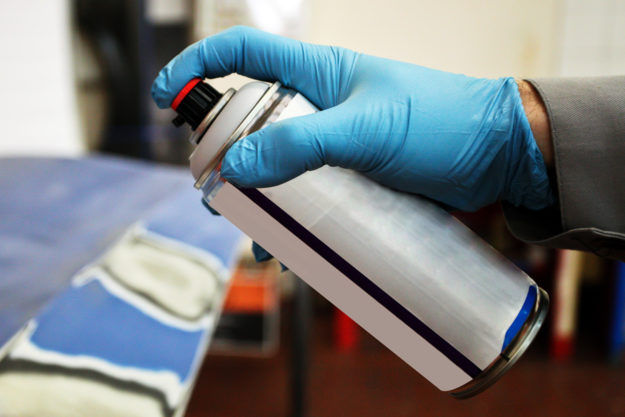
You can get an acceptable result painting in your home shop, if you learn, practice and follow a process. So I’ve broken my process down into six steps: we’ll cover the first three this week, and the rest next time.
Before you start, be sure to talk to your local auto body supplier for detailed product information and recommendations. After you’ve read this article, you should be able to ask intelligent questions.
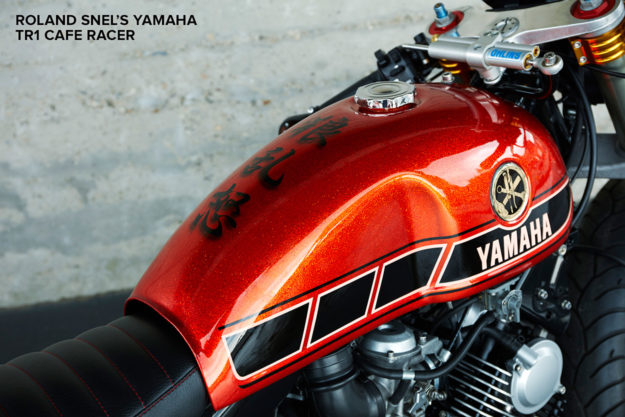
Step 1: Think about the final finish What color scheme does your project have? Will it have lettering, decals, patterns or lines? Flake or flat color? Gloss or matte?
Once you have a final finish in mind, it will help determine the painting process and products needed. A rough design of your paint scheme will help you plan the painting steps, so don’t be afraid to make a sketch with your design drawn in.
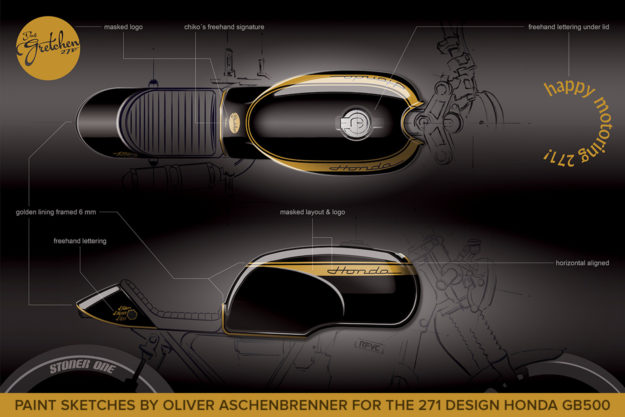
Step 2: Choose a paint system Assuming you don’t have an air compressor for this process, your paint selection is a little limited. So let’s cover some terminology that you might hear around paint technology.
Single stage paint is a paint where the color and the gloss are achieved with a single paint coating. Two-stage paints require one paint layer for the color, and another for the protective clear coat (which could be gloss or matte). These two-stage products are commonly called base coat/clear coat systems.
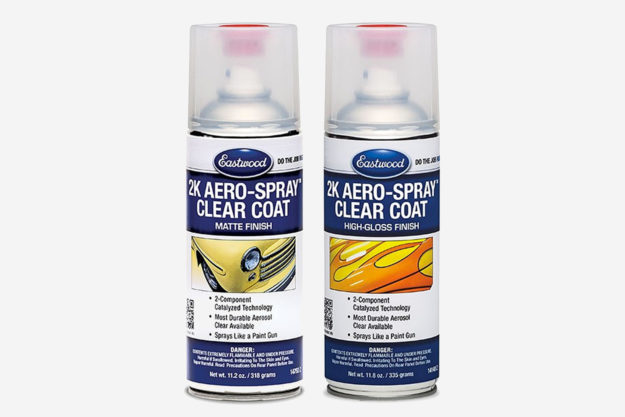
1K coatings are coatings that do not require a hardener, activator or other product to cure. House paint is a basic example of such a product; one-shot pinstriping enamel is another. (Most aerosol paint falls into this category too.)
2K coatings are products mixed with a hardener just prior to spraying, so as to activate a chemical reaction during drying. This provides a durable finished surface much less susceptible to damage from weather, UV rays, fuel or chemicals. Your average body shop will be spraying a 2K finish on modern cars in their spray booth.
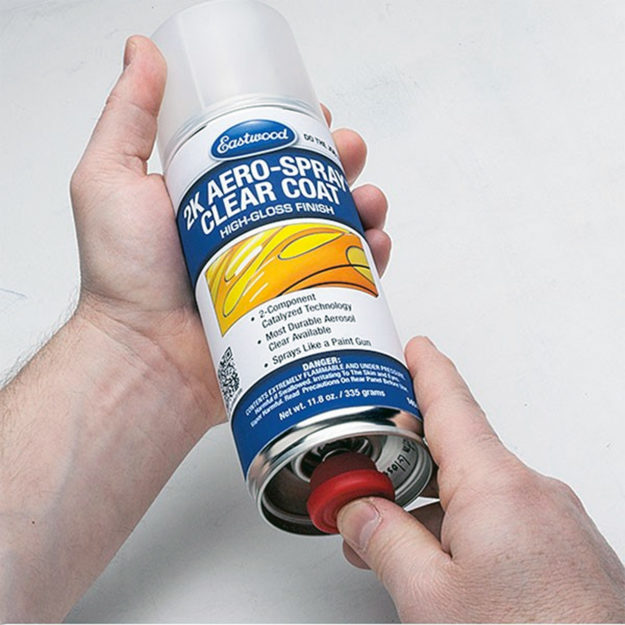
As with everything, there are exceptions. Some vendors can supply an aerosol can that delivers a 2K clear coat. They manage this with a separate chamber in the can that contains the hardener. Right before spraying, you activate the hardener supply and it mixes with the clear coat. You then have a limited window to spray the clear coat before the paint in the can ‘goes off.’
And, of course, you could have a two-stage paint system with a 1K base coat (color) and a 2k clear coat. Online sources like Eastwood are a great place to start investigating your options.
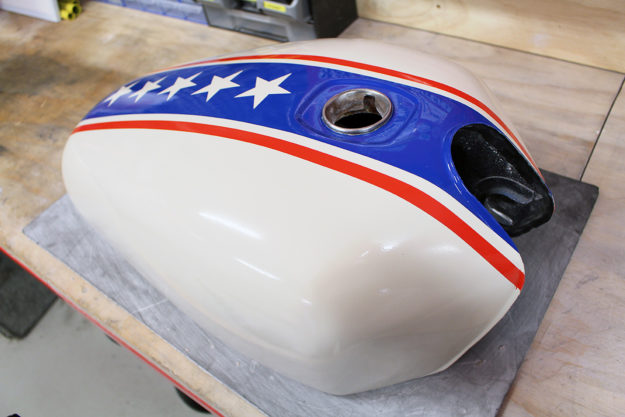
For a personal project, I painted my Kawasaki Ninja ZX-9R motorcycle in black and gold, with a 1K base coat, and a 2K matte clear coat over an eBay sticker kit.
The fuel tank you see above I painted especially for this article. I used a high-quality (read: relatively expensive) enamel aerosol paint from the hardware store, for a couple of reasons:
1. The re-coating time was fast—about 20 minutes. I had lots of paint to lay down, and a deadline!
2. This tank was full of rust holes, so would never go back on a bike, and would only ever be garage art.
3. It was far cheaper than a proper automotive paint.
If you want to tackle a project like this, I’d encourage you to do something similar. Find a surplus tank or fender and practice some of these techniques before you aim the aerosol can at your project bike. At worst, if it doesn’t work out, or you don’t like it, you can strip it off and start again.
Is there better paint for the final finish on your bike than hardware-shop enamel? Yes! Paint product availability will vary depending on where you are in the world, so go ask your local suppliers for advice, or check out the Eastwood site and their resources.

Step 3: Preparation Prep is crucial to a quality finish. My general process is: remove paint, fill, sand, prime, spray putty/filler, sand, and prime again.
Remove Paint You can repaint over an existing coat, whether it’s on a frame or a tank. If the paint is in good condition, you can simply scuff it up with 400 grit wet-and-dry paper and paint over it. You might be taking a risk with compatibility with the original paint, so test the existing paint first. Hold a rag soaked in general purpose thinners on the paint—if the thinners dissolves the existing paint, consider stripping it off.
I much prefer to strip to bare metal regardless. I like to know what I am working with. You can see my favorite methods of removing paint in this article, but paint stripper is available in aerosol cans which might be suitable for a smaller motorcycle project.
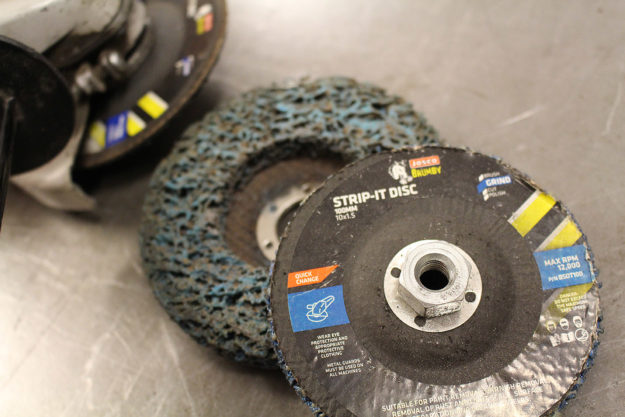
On our project gas tank, I had previously sanded the paint off. The downside of sanding is that it leaves deep scratches in the metal—strip-and-clean discs are a clear winner here.
You may have heard advice about preventing or neutralizing rust on your bare metal. I normally don’t bother, as I go straight to the next step within hours of stripping the paint.
Fill On a new or reproduction tank, or on a frame, you might be able to skip this step. Otherwise, line up some automotive body filler. This is normally a two-part product—you need to mix a hardener with the filler to start a reaction that cures the product.
Before mixing up the filler, put on some disposable gloves to protect your skin. Use wax and grease remover with a clean rag, and wipe over the tank to ensure it is spotless and ready for the next step.
You’ll need a surface to mix the filler. Some sources suggest cardboard will absorb resins from the filler, so I use a $2 plastic chopping board from that big Swedish furniture store. Pick up some plastic body filler spreaders; these are a buck or so. (You can use any stiff plastic card if you’re really on a budget.)
Follow the instructions on the product packaging. Mine said something like “mix one part hardener to 50 parts filler by weight.” I have no idea how you’d actually do this, so I scoop out some filler with the spreader and squeeze out a thin line of hardener across it. Use the plastic spreader to continually fold the mixture into itself until it has a consistent color and texture.
You need to keep moving now, as the filler is starting to cure. Use the plastic spreader to drag filler over the surface. I hold the spreader with my thumb on one side and three fingers on the back—I can then curve it to match the surface better. With a few attempts, you’ll soon determine the best angle and pressure to leave a smooth coat on the surface.
Apply a coat no more than 3mm or 1/8” thick at a time. If you have a deeper dent to build up, apply 3mm then let it dry before applying further coats to build it up.
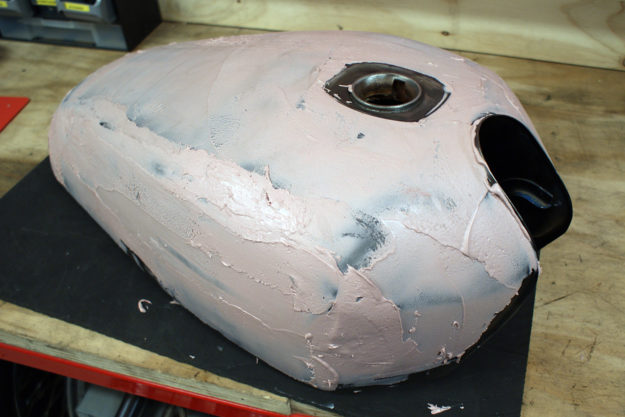
You’ll find the filler getting harder to work as the minutes pass and it cures. Mix up small quantities so you don’t waste any. Aim to smooth out the filler as much as possible; leaving mounds and humps will add a lot of sanding work in the next step.
Sand Once the filler has cured (around 30 minutes if all goes well), you can start sanding. I aim to remove filler as quickly as possible, without leaving massive scratches that I’ll have to fill again later. My hardware store stocks 80 grit aluminum oxide paper in bulk rolls, so I start with this. The 80 grit doesn’t leave significant scratches, and the aluminum oxide paper resists clogging.
While working on this project, I found a 5lb box of assorted grit paper, which would be a good option if you wanted to order online. I also use a color sanding block, which is a firm foam pad that you wrap your abrasive paper around. Rather than a hard, straight block—which is fine for straight, flat surfaces—the color sanding block conforms to a curved surface.
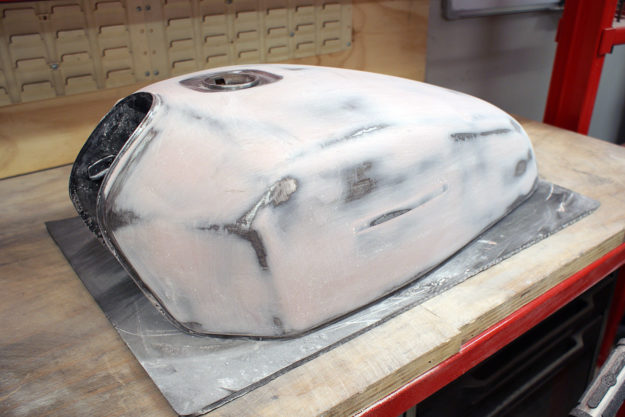
With some reasonably coarse paper wrapped around a color sanding block, start smoothing out the filler. This is dusty work, so wear a disposable dust mask. Keep working though your supply of abrasive paper until the filler is only left in the low spots, such as dents.
Run your hand, palm down, over the surface. You’ll feel any low spots—the filler in these areas isn’t high enough to match the existing surface. Mix up some more and repeat the filling and sanding process.
This step will likely take the longest, but is the foundation for your paint finish. In the tank I painted for this article, I spent around four hours filling and sanding. Mostly sanding. Be aware that while it might look great at the filler stage, the first coat of primer will really help highlight any flaws in this step. If you can see the flaw now, you can guarantee it will be visible under paint. Now is the time to patch it with filler and smooth it out.
Before your progress to the next step, I would recommend progressively finer sanding with 120, 240, and 400 grit papers. I’ve found I sometimes have trouble covering 80 grit sanding scratches in the priming and painting stages if I don’t smooth the filler coat further.
Prime A primer is used to provide a key between the surface and paint, or in this case, between the filler and paint. Your paint supplier will recommend the best primer to suit your final paint finish product. The packaging will suggest how thick to lay it on, and how long you need to wait between coats.
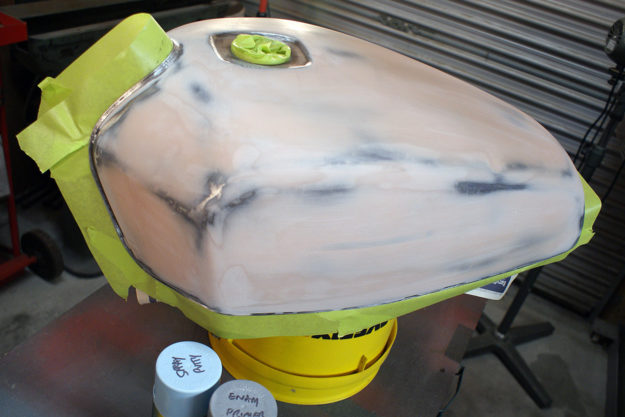
Before you shoot any primer, you’ll need to use tape to mask off any parts that don’t need paint, like the fuel filler. I also mask from behind the tank seam to prevent any paint blowing onto the underside of the tank. I use a reasonable quality painter’s tape, not cheap domestic masking tape.
At the absolute last second before applying primer, or any coat for that matter, use a tack cloth and wipe the surface you’re about to paint. The tack cloth will pick up any dust or dirt that has settled and minimize how much ends up in your paint finish.
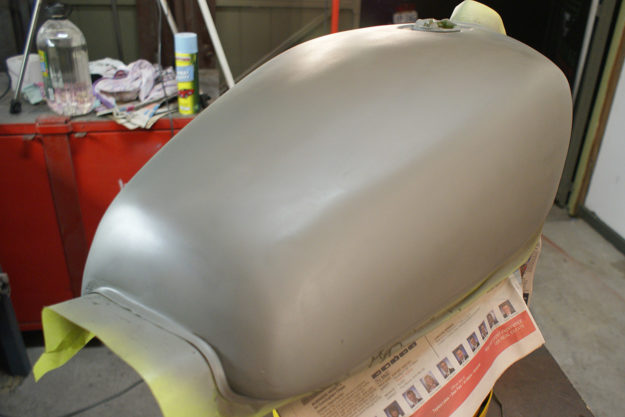
The primer you use might contain some filler product to help smooth the surface. If so, you can sand the primer. You might use a 240 grit at this stage, then a 400 grit before the next step. Taking the high spots off will level out the surface further. If you sand back to the body filler, prime it again before moving to the next step.
If the primer doesn’t contain any filler (or enough to cover any marks) you might add the next step.
Spray putty If you find some minor scratches in the primer, a spray putty can help fill these. Follow the product instructions—the spray putty I use suggests three to four coats, then sanding. Again, you might end up sanding the majority of the putty off, with only the putty in the low spots remaining.
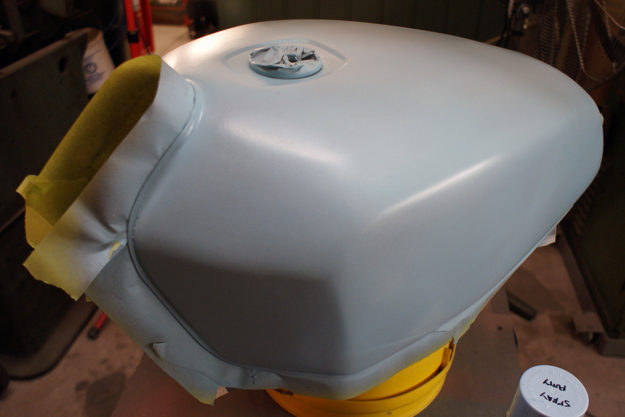
Check your spray putty coverage and sand any marks out. Spot patch with more body filler if the spray putty didn’t cover up your earlier sins. Give it a final sand and check with your hand again. Hopefully you can’t feel any more marks in the surface. If you’ve sanded back to bare metal, or the product recommends more primer over the putty, spray it on before moving to paint. And that’s what we’ll cover in Part II in a couple of weeks.
Download a free Amazon shopping list of supplies and consumables needed for painting a motorcycle exactly like described in this article here.